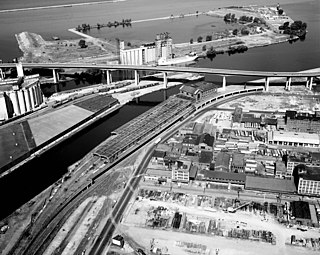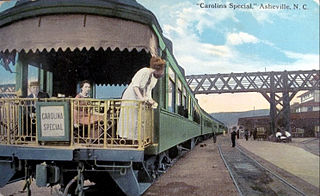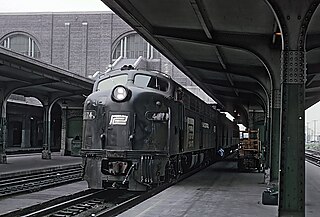
Michigan Services are three Amtrak passenger rail routes connecting Chicago, Illinois with the Michigan cities of Grand Rapids, Port Huron, and Pontiac, and stations en route. The group falls under the Amtrak Midwest brand and is a component of the Midwest Regional Rail Initiative.

The Michigan Central Railroad was originally chartered in 1832 to establish rail service between Detroit, Michigan, and St. Joseph, Michigan. The railroad later operated in the states of Michigan, Indiana, and Illinois in the United States and the province of Ontario in Canada. After about 1867 the railroad was controlled by the New York Central Railroad, which later became part of Penn Central and then Conrail. After the 1998 Conrail breakup, Norfolk Southern Railway now owns much of the former Michigan Central trackage.

The Metro Rail Maintenance Yard or "South Park Terminal" houses Buffalo Metro Rail's cars in a train shed at the former Delaware, Lackawanna and Western Railroad terminal in the Cobblestone District of Buffalo, New York. The property is located at the southernmost fringe of the Central Business District. The station was built in 1917, and was designed to handle both steam trains and steamships. The storage and maintenance facility was converted to its present condition in 1982, following the demolition of the former main terminal concourse building "headhouse" of the DL&W Terminal in 1979.

The Empire State Express was one of the named passenger trains and onetime flagship of the New York Central & Hudson River Railroad. On September 14, 1891, it covered the 436 miles (702 kilometers) between New York City and Buffalo in 7 hours and 6 minutes, averaging 61.4 miles-per-hour (98.8 km/h), with a top speed of 82 mph (132 km/h).

Durand Union Station is a historic train station in Durand, Michigan. The station, which now serves Amtrak Blue Water trains, was originally a busy Grand Trunk Western Railroad and Ann Arbor Railroad hub, as well as a local office for Grand Trunk Western, from its construction in 1903 until 1974. It is currently owned by the city of Durand and leased by Durand Union Station, Inc. a nonprofit organization dedicated to the preservation, restoration, and maintenance of the building and its surrounding property.

The Cincinnatian was a named passenger train operated by the Baltimore and Ohio Railroad (B&O). The B&O inaugurated service on January 19, 1947, with service between Baltimore, Maryland and Cincinnati, Ohio, carrying the number 75 westbound and 76 eastbound, essentially a truncated route of the National Limited which operated between Jersey City, New Jersey and St. Louis.
Northern Arrow was one of the named passenger trains of the Pennsylvania Railroad, starting at Cincinnati, Ohio and ending at Mackinaw City, Michigan. It had merging branches originating from Chicago, Illinois, converging in Fort Wayne, Indiana, and a train from St. Louis, Missouri from the west, converging at Richmond, Indiana. Carrying the number #519 northbound and #520 southbound, it used the Grand Rapids and Indiana Railroad, a leased subsidiary of the Pennsylvania system.

Michigan City station was a train station in Michigan City, Indiana served by Amtrak, the national railroad passenger system. It was served by two eastbound and one westbound Wolverine train at the time of closure; other Wolverine and Blue Water trains did not stop. The station had a platform shelter near the former prairie-style Michigan Central Railroad depot dating from 1915, which is now a local restaurant. That earlier station served Michigan Central Railroad, and later, New York Central passenger trains. Major NYC named trains passing through the station included the Canadian, the Chicago Mercury and the Wolverine.

The Union Depot is a former train station, located at 637 E. Michigan Avenue in Lansing, Michigan. It was listed on the National Register of Historic Places in 1995. Despite the union name, Grand Trunk Western trains stopped at a different station 1 mile away. Lake Shore and Michigan Southern Railway trains of the former Lansing Division stopped at another station a quarter mile away.
The Night Express was an American named train of the Baltimore and Ohio Railroad (B&O) on its route between Detroit, Michigan, and Louisville, Kentucky, with major station stops in Toledo, Ohio, and Cincinnati. The service was numbered Train 57 southbound and Train 58 northbound. The numbers 57/58 operated on the Detroit - Cincinnati line as early as 1921. The service was provided in conjunction with the Pere Marquette Railroad from Detroit to Toledo and with the Louisville and Nashville from Cincinnati to Louisville with connections to New Orleans.

Battle Creek station, listed in the National Register of Historic Places as the Penn Central Railway Station, is a disused train station in Battle Creek, Michigan. It opened on July 27, 1888. Rogers and MacFarlane of Detroit designed the depot, one of several Richardsonian Romanesque-style stations between Detroit and Chicago in the late nineteenth century. Masonry of Lake Superior red sandstone, noted for its distinctive patterns, provides one of the most striking aspects of the Depot's exterior. Another prominent feature of the Depot is its clock tower.

The Niagara Rainbow, known as the Empire State Express before 1976, was an American passenger train service operated by Amtrak between New York City and Detroit via Buffalo and Southwestern Ontario in Canada. The service ran between October 31, 1974, and January 31, 1979.

The Canada Southern Railway Station (CASO) is a former railway station in St. Thomas, Ontario, Canada. The station was built by the Canada Southern Railway (CSR) in 1873 as both a railway station and its corporate headquarters. It was one of the busiest stations in Canada during the 1920s. Train traffic ceased in the 1980s.

The Carolina Special was a passenger train operated by the Southern Railway between Cincinnati, Ohio, and the Carolinas. It operated from 1911 to 1968. It was the last passenger train to use the route of the Charleston and Hamburg Railroad, which, as the South Carolina Canal and Railroad Company, began operation in December 1830, as one of the oldest railroads in the United States, and, by 1833, operated a 136-mile (219 km) line to Hamburg, South Carolina, on the Savannah River, the country's longest at that time. All Southern Railway Pullman service to Charleston rode over that historic, if bucolic, route from Branchville to the port city.

Windsor was a train station in Windsor, Ontario, Canada. The station was built by the Michigan Central Railroad in 1911 and subsequently controlled by the Canada Southern Railway. The station served Canada Southern Railway and New York Central trains. Windsor also has another railroad station in town.
The Southland was a night train between Chicago, Illinois and different points in western and eastern Florida from 1915 to 1957. In the early years it was called the New Southland. It was distinctive among Midwest to Florida trains as its western branch was the only all-season mid-20th-century long-distance train passing from Georgia to Florida bypassing the usual passenger train hub of Jacksonville Union Station. The main operator was the Louisville and Nashville Railroad, and pooling partners were the Pennsylvania Railroad, the Atlantic Coast Line Railroad and to lesser extent, the Wabash Railroad and the Florida East Coast Railway. For southeast bound -but not northwest bound- trips to Norfolk, Virginia, some coaches in 1946 diverged at Cincinnati along a Norfolk and Western Railway route. Northwest bound, travelers could switch trains at Cincinnati for heading towards Chicago.
The Wolverine was an international night train that twice crossed the Canada–United States border, going from New York City to Chicago. This New York Central Railroad train went northwest of Buffalo, New York, into Canada, traveled over Michigan Central Railroad tracks, through Windsor, Ontario, reentering the United States, through Detroit's Michigan Central Station, and on to Chicago. At the post-World War II peak of long-distance named trains, there were three other New York Central trains making this unusual itinerary through Southwestern Ontario. In the late 1960s, this was the last remaining train taking this route, failing to survive into the Penn Central era. The name resurfaced on the truncated Detroit–Chicago route with Amtrak's Wolverine.

The Buffalo Day Express was a long-distance north–south Pennsylvania Railroad passenger train from Washington, D.C., to Buffalo, New York. It had a second branch that originated in Philadelphia, Pennsylvania, and at times, from New York, New York. In the southbound direction, the train ran by the name, Washington Express. It was the longest running of trains on the Washington-Buffalo route, north through central Pennsylvania on the Buffalo Line, operating from 1900 to the latter years of the 1960s, with a shortened segment until 1971.

Canton station, or Canton–Akron station, is a former train station in Canton, Ohio.
The Canadian and later, Canadian-Niagara, was the longest running named international train from Chicago to Upper Canada via Detroit, for its first two decades running to Montreal. This overnight train was operated by the Michigan Central Railroad from Chicago to Detroit, and in a pool arrangement, it operated over Canadian Pacific Railway tracks and used the same train number from Detroit eastward. The train would carry a second section, bound, variously for Buffalo or New York City via Buffalo.














